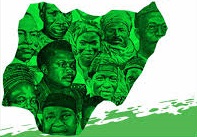
Nigeria has a rich and diverse history, with various ancient kingdoms, empires, and city-states flourishing across its regions before European colonization. Here’s an overview of Nigeria’s pre-colonial history, divided by major regions:

1. Northern Nigeria (Hausa Kingdoms, Kanem-Bornu, and Others)
-
Hausa Kingdoms (7th–19th century):
The Hausa people established seven major city-states (Hausa Bakwai): Daura, Kano, Katsina, Zaria, Gobir, Rano, and Biram. These states were centers of trade, Islamic scholarship, and governance.-
Kano became a major commercial hub under Sarki Muhammad Rumfa (15th century).
-
Zaria (Zazzau) was ruled by Queen Amina in the 16th century, known for her military conquests.
-
-
Kanem-Bornu Empire (9th–19th century):
-
Originated around Lake Chad, the Kanem Empire later shifted to Bornu.
-
Under Mai Idris Alooma (16th century), it became a powerful Islamic state with strong military and trade networks (trans-Saharan trade).
-
-
Sokoto Caliphate (1804–1903):
-
Founded by Usman dan Fodio after a jihad against Hausa rulers.
-
Became one of Africa’s largest pre-colonial states, governed by Islamic law.
-
2. Southwestern Nigeria (Yoruba Kingdoms)
-
Ife Kingdom (11th–15th century):
-
Regarded as the spiritual homeland of the Yoruba people.
-
Famous for its terracotta and bronze sculptures (Ife art).
-
-
Oyo Empire (14th–19th century):
-
One of the most powerful Yoruba states, known for its cavalry and political system (Alaafin as king).
-
Controlled trade routes to the coast and engaged in the slave trade.
-
Declined due to internal strife and Fulani invasions.
-
-
Benin Kingdom (11th–19th century):
-
Although Edo-speaking, Benin had strong ties with Yoruba states.
-
Famous for its bronze plaques, ivory carvings, and walled city.
-
Ruled by the Oba (king), with significant influence over trade with Europeans.
-
3. Southeastern Nigeria (Igbo and Other Societies)
-
Nri Kingdom (10th–20th century):
-
A spiritual and political center for the Igbo people.
-
The Eze Nri was a religious leader who spread cultural practices like the Iguaro (yam title) system.
-
-
Aro Confederacy (17th–19th century):
-
Dominated the slave trade through the Arochukwu oracle (Long Juju).
-
Controlled trade routes between the coast and hinterlands.
-
-
City-States (Onitsha, Aboh, etc.):
-
Independent communities with republican systems (no centralized kingship).
-
Trade with Europeans (especially palm oil in the 19th century).
-
4. Niger Delta & Coastal Regions (City-States and Trade Hubs)
-
Kalabari, Bonny, and Opobo:
-
Controlled trade with Europeans (slaves, later palm oil).
-
Ruled by wealthy merchant kings like Jaja of Opobo.
-
-
Efik Kingdom (Calabar):
-
Major center for the slave trade and later missionary activities.
-
5. Middle Belt (Diverse Ethnic Groups)
-
Jukun, Nupe, and Tiv:
-
The Jukun (Kwararafa) had a powerful kingdom that rivaled Hausaland.
-
The Nupe Kingdom was influenced by Islamic culture and engaged in wars with Oyo.
-
European Contact & Decline of Kingdoms (15th–19th Century)
-
Portuguese (1472): First Europeans to reach Nigeria (Benin, Warri).
-
Slave Trade (16th–19th century): Coastal kingdoms grew wealthy but suffered from warfare.
-
British Colonization (19th century): The fall of the Sokoto Caliphate and Benin in 1897 marked the end of most independent kingdoms.
Conclusion
Nigeria’s pre-colonial history was shaped by powerful empires, trade networks (trans-Saharan and Atlantic), and diverse political systems (monarchies, city-states, and republics). The British later merged these distinct regions into one colony in 1914, forming modern Nigeria.
Thank you for following us incase you find any error in our contents please kindly send us mail or you need additional information you want us to add to any history kindly send us because all what we are posted was generated according to what we see online or we have acknowledged about in this case we can’t perfect in 100% kindly correct us in any aspect you find that’s need.
Noted:- We are not copy from any blog if you fund one your line or content is attach to our post kinky report to our [email protected] and we promise you we are going to rephrase it immediately thanks so much we love you all.
Leave a Reply